Catapulting Into History
Updated: 2012-11-30 14:15:58
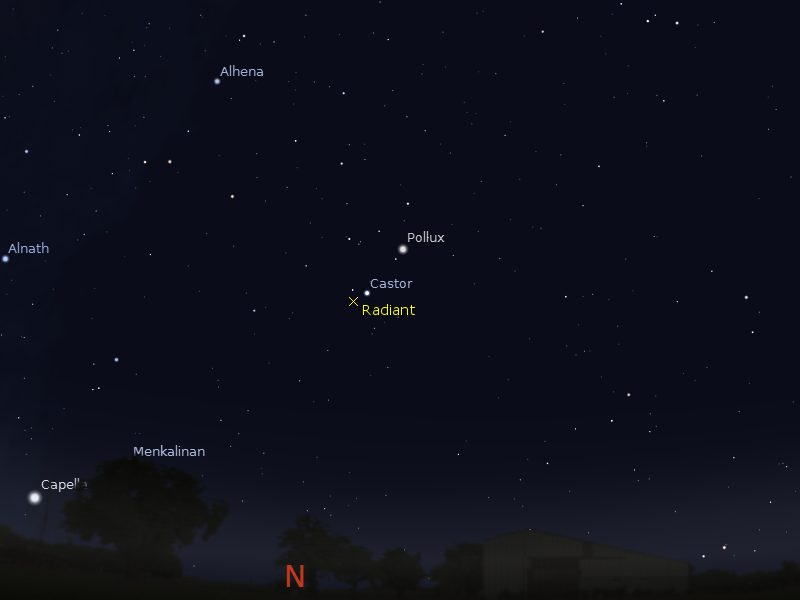 : . Astroblog Obscured by Clouds . The rough and ready blog of a cloud benighted biologist and amateur astronomer . Astroblog will cover my interests in astronomy , biology and Life , the Universe and . Everything Saturday , December 01, 2012 Southern Skywatch December 2012 Edition is now . up Morning sky as seen from Adelaide at 3:00 am ACDST on December 14 showing the Geminid meteor shower radiant click on image to embiggen The December edition of Southern Skywatch is now . up There's still lots of planetary action this . month Venus is low in the morning sky and is close to the crescent Moon on the 12th . On December 11 the crescent Moon s is close to Saturn Jupiter is in the morning sky near the Hyades . Jupiter is at opposition on the 3rd , when it is largest as seen from Earth , this
: . Astroblog Obscured by Clouds . The rough and ready blog of a cloud benighted biologist and amateur astronomer . Astroblog will cover my interests in astronomy , biology and Life , the Universe and . Everything Saturday , December 01, 2012 Southern Skywatch December 2012 Edition is now . up Morning sky as seen from Adelaide at 3:00 am ACDST on December 14 showing the Geminid meteor shower radiant click on image to embiggen The December edition of Southern Skywatch is now . up There's still lots of planetary action this . month Venus is low in the morning sky and is close to the crescent Moon on the 12th . On December 11 the crescent Moon s is close to Saturn Jupiter is in the morning sky near the Hyades . Jupiter is at opposition on the 3rd , when it is largest as seen from Earth , this Skip to content Parabolic Arc Space Tourism and Much More News Search Archives Parabolic Reading List Polls Archive Congressmen Seek to Rename NASA Dryden After Neil Armstrong Private-Public Partnership Transforms Former Shuttle Processing Facility Posted by Doug Messier on November 30, 2012, at 5:34 am in News Tags : Boeing NASA NASA KSC Comments : no responses 0 Comments This artist concept is what The Boeing Company’s CST-100 spacecraft processing is expected to look like in Space Florida’s Commercial Crew and Cargo Processing Facility at NASA’s Kennedy Space Center in Florida with work stations on a clean floor . Credit : Boeing By Rebecca Regan Kennedy Space Center , . Fla A facility full of platforms that once fit NASA’s space shuttles like a glove is transitioning to make room for a
Skip to content Parabolic Arc Space Tourism and Much More News Search Archives Parabolic Reading List Polls Archive Congressmen Seek to Rename NASA Dryden After Neil Armstrong Private-Public Partnership Transforms Former Shuttle Processing Facility Posted by Doug Messier on November 30, 2012, at 5:34 am in News Tags : Boeing NASA NASA KSC Comments : no responses 0 Comments This artist concept is what The Boeing Company’s CST-100 spacecraft processing is expected to look like in Space Florida’s Commercial Crew and Cargo Processing Facility at NASA’s Kennedy Space Center in Florida with work stations on a clean floor . Credit : Boeing By Rebecca Regan Kennedy Space Center , . Fla A facility full of platforms that once fit NASA’s space shuttles like a glove is transitioning to make room for a Popular Astronomy: Universe Awareness - Space Scoop:
Popular Astronomy: Universe Awareness - Space Scoop: AmericaSpace: This stunning image of the Sun was captured using a Hydrogen Alpha solar scope from Deerlick Astronomy Village. Photo Credit: Chris Hetlage / Imaging the Cosmos While Chris Hetlage’s astrophotography at Imaging the Cosmos is amazing, the imagery he has produced of our nearest star, the Sun, has been nothing short of epic. The [...]
AmericaSpace: This stunning image of the Sun was captured using a Hydrogen Alpha solar scope from Deerlick Astronomy Village. Photo Credit: Chris Hetlage / Imaging the Cosmos While Chris Hetlage’s astrophotography at Imaging the Cosmos is amazing, the imagery he has produced of our nearest star, the Sun, has been nothing short of epic. The [...] : Friday , November 30, 2012 Solar eclipse from 37 kilometers up Jason Major Universe Today By launching a weather balloon carrying a wide-angle camera into the stratosphere above Queensland , eclipse hunter and amateur astronomer Catalin Beldea and her team were able to obtain their incredible video of the November 14 total eclipse from high enough up that the shadow of the Moon was visible striking Earth’s atmosphere . Totality only lasted a couple of minutes so good timing was essential but they got the shot . Very impressive Read Jason's article , In the Shadow of the Moon , at Universe Today HERE The video was organized with and for Romania’s Stiinta Tehnica.com by editor-in-chief Marc Ulieriu and assembled by Daniel Toma . Music by Shamil . Elvenheim Posted by Joel Raupe at 9:42 AM
: Friday , November 30, 2012 Solar eclipse from 37 kilometers up Jason Major Universe Today By launching a weather balloon carrying a wide-angle camera into the stratosphere above Queensland , eclipse hunter and amateur astronomer Catalin Beldea and her team were able to obtain their incredible video of the November 14 total eclipse from high enough up that the shadow of the Moon was visible striking Earth’s atmosphere . Totality only lasted a couple of minutes so good timing was essential but they got the shot . Very impressive Read Jason's article , In the Shadow of the Moon , at Universe Today HERE The video was organized with and for Romania’s Stiinta Tehnica.com by editor-in-chief Marc Ulieriu and assembled by Daniel Toma . Music by Shamil . Elvenheim Posted by Joel Raupe at 9:42 AM The Moon’s shadow stretches over the Earth in this balloon-mounted camera view of the November 14 solar eclipse (Catalin Beldea, Marc Ulieriu, Daniel Toma et. al/Stiinta&Tehnica) On November 14, 2012, tens of thousands of viewers across northeastern Australia got a great view of one of the most awe-inspiring sights in astronomy — a total solar [...]
The Moon’s shadow stretches over the Earth in this balloon-mounted camera view of the November 14 solar eclipse (Catalin Beldea, Marc Ulieriu, Daniel Toma et. al/Stiinta&Tehnica) On November 14, 2012, tens of thousands of viewers across northeastern Australia got a great view of one of the most awe-inspiring sights in astronomy — a total solar [...]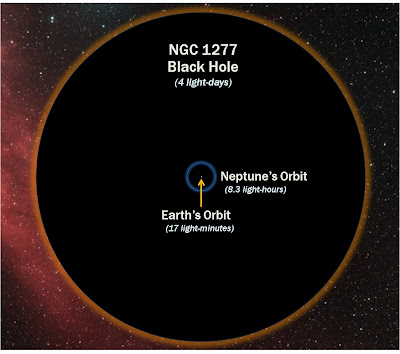 skip to main skip to sidebar Pages Home November 29, 2012 Supermassive Blackhole with 17 billion solar mass has 14 of the mass of its galaxy Email This BlogThis Share to Twitter Share to Facebook Tweet Astronomers have used the Hobby-Eberly Telescope at The University of Texas at Austin's McDonald Observatory to measure the mass of what may be the most massive black hole yet 17 billion Suns in galaxy NGC 1277. The unusual black hole makes up 14 percent of its galaxy's mass , rather than the usual 0.1 percent . This galaxy and several more in the same study could change theories of how black holes and galaxies form and . evolve NGC 1277 lies 220 million light-years away in the constellation Perseus . The galaxy is only ten percent the size and mass of our own Milky Way . Despite NGC 1277's
skip to main skip to sidebar Pages Home November 29, 2012 Supermassive Blackhole with 17 billion solar mass has 14 of the mass of its galaxy Email This BlogThis Share to Twitter Share to Facebook Tweet Astronomers have used the Hobby-Eberly Telescope at The University of Texas at Austin's McDonald Observatory to measure the mass of what may be the most massive black hole yet 17 billion Suns in galaxy NGC 1277. The unusual black hole makes up 14 percent of its galaxy's mass , rather than the usual 0.1 percent . This galaxy and several more in the same study could change theories of how black holes and galaxies form and . evolve NGC 1277 lies 220 million light-years away in the constellation Perseus . The galaxy is only ten percent the size and mass of our own Milky Way . Despite NGC 1277's skip to main skip to sidebar Pages Home November 29, 2012 Researchers Create Versatile 3D Nanostructures Using DNA Bricks Email This BlogThis Share to Twitter Share to Facebook Tweet Researchers at the Wyss Institute for Biologically Inspired Engineering at Harvard University have created more than 100 three-dimensional 3D nanostructures using DNA building blocks that function like Lego® bricks a major advance from the two-dimensional 2D structures the same team built a few months . ago In effect , the advance means researchers just went from being able to build a flat wall of Legos® , to building a house . The new method , featured as a cover research article in the 30 November issue of Science , is the next step toward using DNA nanotechnologies for more sophisticated applications than
skip to main skip to sidebar Pages Home November 29, 2012 Researchers Create Versatile 3D Nanostructures Using DNA Bricks Email This BlogThis Share to Twitter Share to Facebook Tweet Researchers at the Wyss Institute for Biologically Inspired Engineering at Harvard University have created more than 100 three-dimensional 3D nanostructures using DNA building blocks that function like Lego® bricks a major advance from the two-dimensional 2D structures the same team built a few months . ago In effect , the advance means researchers just went from being able to build a flat wall of Legos® , to building a house . The new method , featured as a cover research article in the 30 November issue of Science , is the next step toward using DNA nanotechnologies for more sophisticated applications than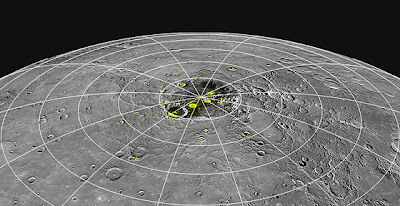 skip to main skip to sidebar Pages Home November 29, 2012 Scientists discover 20 billion to 1 trillion tons of water ice on Mercur Email This BlogThis Share to Twitter Share to Facebook Tweet Mercury , the smallest and innermost planet in our solar system , revolves around the sun in a mere 88 days , making a tight orbit that keeps the planet incredibly toasty . Surface temperatures on Mercury can reach a blistering 800 degrees Fahrenheit hot enough to liquefy lead . Now researchers from NASA , MIT , the University of California at Los Angeles and elsewhere have discovered evidence that the scorching planet may harbor pockets of water ice , along with organic material , in several permanently shadowed craters near Mercury’s north pole . Mapping the planet’s surface is a challenging task ,
skip to main skip to sidebar Pages Home November 29, 2012 Scientists discover 20 billion to 1 trillion tons of water ice on Mercur Email This BlogThis Share to Twitter Share to Facebook Tweet Mercury , the smallest and innermost planet in our solar system , revolves around the sun in a mere 88 days , making a tight orbit that keeps the planet incredibly toasty . Surface temperatures on Mercury can reach a blistering 800 degrees Fahrenheit hot enough to liquefy lead . Now researchers from NASA , MIT , the University of California at Los Angeles and elsewhere have discovered evidence that the scorching planet may harbor pockets of water ice , along with organic material , in several permanently shadowed craters near Mercury’s north pole . Mapping the planet’s surface is a challenging task , AmericaSpace: Shown in red are areas of Mercury’s north polar region that are constantly in shadow in every image that the MESSENGER spacecraft has acquired to date. These areas are rich in water ice, despite the planet’s colse proximity to the sun. Image Credit: NASA/Johns Hopkins University Applied Physics Laboratory/Carnegie Institution of Washington/National Astronomy and [...]
AmericaSpace: Shown in red are areas of Mercury’s north polar region that are constantly in shadow in every image that the MESSENGER spacecraft has acquired to date. These areas are rich in water ice, despite the planet’s colse proximity to the sun. Image Credit: NASA/Johns Hopkins University Applied Physics Laboratory/Carnegie Institution of Washington/National Astronomy and [...] AmericaSpace: This artist’s impression of Saturn’s moon, Titan, shows the change in observed atmospheric effects before, during, and after equinox in 2009. The Titan globes also provide an impression of the detached haze layer that extends all around the moon (blue). This image was inspired by data from NASA’s Cassini mission. Image Credit: ESA PASADENA, [...]
AmericaSpace: This artist’s impression of Saturn’s moon, Titan, shows the change in observed atmospheric effects before, during, and after equinox in 2009. The Titan globes also provide an impression of the detached haze layer that extends all around the moon (blue). This image was inspired by data from NASA’s Cassini mission. Image Credit: ESA PASADENA, [...]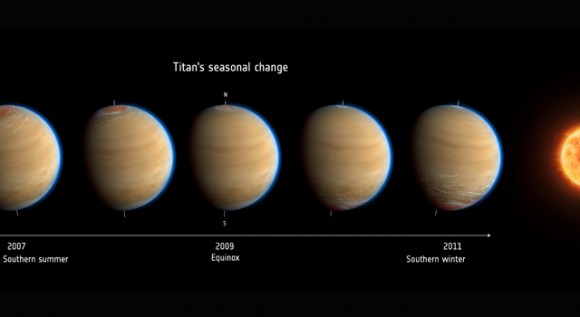 This artist’s impression of Saturn’s moon Titan shows the change in observed atmospheric effects before, during and after equinox in 2009. The Titan globes also provide an impression of the detached haze layer that extends all around the moon (blue). This image was inspired by data from NASA’s Cassini mission. Image Credit: ESA A certain [...]
This artist’s impression of Saturn’s moon Titan shows the change in observed atmospheric effects before, during and after equinox in 2009. The Titan globes also provide an impression of the detached haze layer that extends all around the moon (blue). This image was inspired by data from NASA’s Cassini mission. Image Credit: ESA A certain [...]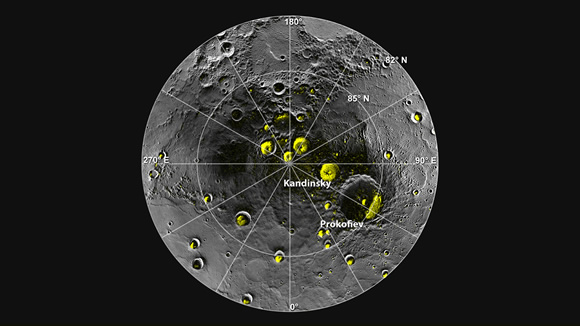 A radar image of Mercury’s north polar region is shown superposed on a mosaic of MESSENGER images of the same area. All of the larger polar deposits are located on the floors or walls of impact craters. Deposits farther from the pole are seen to be concentrated on the north-facing sides of craters. Credit: NASA/Johns [...]
A radar image of Mercury’s north polar region is shown superposed on a mosaic of MESSENGER images of the same area. All of the larger polar deposits are located on the floors or walls of impact craters. Deposits farther from the pole are seen to be concentrated on the north-facing sides of craters. Credit: NASA/Johns [...]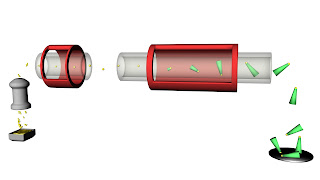 skip to main skip to sidebar Pages Home November 28, 2012 Nanoparticles of gold used as substrate to grow semiconductor nanowires about 1000 times faster Email This BlogThis Share to Twitter Share to Facebook Tweet A completely new method of manufacturing the smallest structures in electronics could make their manufacture thousands of times quicker , allowing for cheaper semiconductors . Instead of starting from a silicon wafer or other substrate , as is usual today , researchers have made it possible for the structures to grow from freely suspended nanoparticles of gold in a flowing . gas They believe the technology will be ready for commercialisation in two to four years’ time . A prototype for solar cells is expected to be completed in two years . When I first suggested the idea of
skip to main skip to sidebar Pages Home November 28, 2012 Nanoparticles of gold used as substrate to grow semiconductor nanowires about 1000 times faster Email This BlogThis Share to Twitter Share to Facebook Tweet A completely new method of manufacturing the smallest structures in electronics could make their manufacture thousands of times quicker , allowing for cheaper semiconductors . Instead of starting from a silicon wafer or other substrate , as is usual today , researchers have made it possible for the structures to grow from freely suspended nanoparticles of gold in a flowing . gas They believe the technology will be ready for commercialisation in two to four years’ time . A prototype for solar cells is expected to be completed in two years . When I first suggested the idea of The full Moon rising with Jupiter and Aldebaran on November 28, 2012 in North Carolina, USA. Credit: Tavi Greiner. The full Moon is a-rising tonight, and it is not alone. There are lots of other bright and beautiful stars and planets out there — some snuggling right up together — and already we’ve got astrophotographers [...]
The full Moon rising with Jupiter and Aldebaran on November 28, 2012 in North Carolina, USA. Credit: Tavi Greiner. The full Moon is a-rising tonight, and it is not alone. There are lots of other bright and beautiful stars and planets out there — some snuggling right up together — and already we’ve got astrophotographers [...] skip to main skip to sidebar Pages Home November 28, 2012 US Crude Production continues to increase by about 150,000 barrel per day per month since Summer of 2012 Email This BlogThis Share to Twitter Share to Facebook Tweet US daily crude oil production increased to 6.818 million barrels per . day This was an increase of 108,000 barrels per day from the prior week . This is the most crude oil produced by the US since February , 1994. This seems to indicate that oil from North Dakota Bakken and Texas Eagle Ford has likely increased by 200,000 to 300,000 barrels per day since the September , 2012 state level oil . reports US Total daily oil liquids production is 11.17 million barrels per . day If you liked this article , please give it a quick review on ycombinator or StumbleUpon Thanks
skip to main skip to sidebar Pages Home November 28, 2012 US Crude Production continues to increase by about 150,000 barrel per day per month since Summer of 2012 Email This BlogThis Share to Twitter Share to Facebook Tweet US daily crude oil production increased to 6.818 million barrels per . day This was an increase of 108,000 barrels per day from the prior week . This is the most crude oil produced by the US since February , 1994. This seems to indicate that oil from North Dakota Bakken and Texas Eagle Ford has likely increased by 200,000 to 300,000 barrels per day since the September , 2012 state level oil . reports US Total daily oil liquids production is 11.17 million barrels per . day If you liked this article , please give it a quick review on ycombinator or StumbleUpon Thanks This weekend the International Space Station will turn itself to face the Sun, enabling ESA’s SOLAR instrument to capture an entire rotation of the solar surface. This is the first time the Station has changed attitude for scientific reasons alone. This instrument has been on the ISS since 2008, and for the first time will [...]
This weekend the International Space Station will turn itself to face the Sun, enabling ESA’s SOLAR instrument to capture an entire rotation of the solar surface. This is the first time the Station has changed attitude for scientific reasons alone. This instrument has been on the ISS since 2008, and for the first time will [...]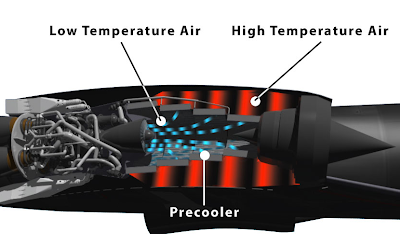 skip to main skip to sidebar Pages Home November 28, 2012 Skylon Spaceplane Pre-cooler Technology Validated Email This BlogThis Share to Twitter Share to Facebook Tweet Reaction Engines has declared their revolutionary pre-cooler technology a . success The Sabre engine could take a plane to five times the speed of sound and an altitude of 25 km , about 20 percent of the speed and altitude needed to reach orbit . For space access , the engines would then switch to rocket mode to do the remaining 80 . percent Reaction Engines believes Sabre is the only engine of its kind in development and the company now needs to raise about 250 million pounds 400 million to fund the next three-year development phase in which it plans to build a small-scale version of the complete . engine The engine
skip to main skip to sidebar Pages Home November 28, 2012 Skylon Spaceplane Pre-cooler Technology Validated Email This BlogThis Share to Twitter Share to Facebook Tweet Reaction Engines has declared their revolutionary pre-cooler technology a . success The Sabre engine could take a plane to five times the speed of sound and an altitude of 25 km , about 20 percent of the speed and altitude needed to reach orbit . For space access , the engines would then switch to rocket mode to do the remaining 80 . percent Reaction Engines believes Sabre is the only engine of its kind in development and the company now needs to raise about 250 million pounds 400 million to fund the next three-year development phase in which it plans to build a small-scale version of the complete . engine The engine skip to main skip to sidebar Pages Home November 27, 2012 Enriched uranium fission reactor prototype for space power systems Email This BlogThis Share to Twitter Share to Facebook Tweet A team of researchers , including engineers from Los Alamos National Laboratory , has demonstrated a new concept for a reliable nuclear reactor that could be used on space . flights The research team recently demonstrated the first use of a heat pipe to cool a small nuclear reactor and power a Stirling engine at the Nevada National Security Site’s Device Assembly Facility near Las Vegas . The Demonstration Using Flattop Fissions DUFF experiment produced 24 watts of . electricity The heat pipe and Stirling engine used in this test are meant to represent one module that could be used in a space system , 8221
skip to main skip to sidebar Pages Home November 27, 2012 Enriched uranium fission reactor prototype for space power systems Email This BlogThis Share to Twitter Share to Facebook Tweet A team of researchers , including engineers from Los Alamos National Laboratory , has demonstrated a new concept for a reliable nuclear reactor that could be used on space . flights The research team recently demonstrated the first use of a heat pipe to cool a small nuclear reactor and power a Stirling engine at the Nevada National Security Site’s Device Assembly Facility near Las Vegas . The Demonstration Using Flattop Fissions DUFF experiment produced 24 watts of . electricity The heat pipe and Stirling engine used in this test are meant to represent one module that could be used in a space system , 8221 skip to main skip to sidebar Pages Home November 27, 2012 Industrial Internet” Report From GE Finds That Combination of Networks and Machines Could Add 10 to 15 Trillion to Global GDP Email This BlogThis Share to Twitter Share to Facebook Tweet GE the Industrial Revolution radically changed the way we use energy and make things . The Internet Revolution altered how we communicate , consume information , and spend money . A combination of these two transformations , called the Industrial Internet , now links networks , data and machines . It promises to remake global industry , boost productivity , and launch an entirely new age of prosperity and robust . growth The authors found that in the U.S . alone the Industrial Internet could boost average incomes by 25 to 40 percent over the next 20
skip to main skip to sidebar Pages Home November 27, 2012 Industrial Internet” Report From GE Finds That Combination of Networks and Machines Could Add 10 to 15 Trillion to Global GDP Email This BlogThis Share to Twitter Share to Facebook Tweet GE the Industrial Revolution radically changed the way we use energy and make things . The Internet Revolution altered how we communicate , consume information , and spend money . A combination of these two transformations , called the Industrial Internet , now links networks , data and machines . It promises to remake global industry , boost productivity , and launch an entirely new age of prosperity and robust . growth The authors found that in the U.S . alone the Industrial Internet could boost average incomes by 25 to 40 percent over the next 20 You may have read about rumors that NASA is considering building a space station at a place called the “Earth-Moon L2 Point.” The “L” is short for “Lagrange,” and this is one of the places in space known as a … Continue reading →
You may have read about rumors that NASA is considering building a space station at a place called the “Earth-Moon L2 Point.” The “L” is short for “Lagrange,” and this is one of the places in space known as a … Continue reading → It’s official - the 2013 ISEC Space Elevator Conference will be held on August 23rd, 24th and 25th, 2013 (Friday, Saturday and Sunday) at the Museum of Flight in Seattle, Washington.
This is the same place as the 2012 Conference was held at and it is a truly fine venue for an event such as ours.
Planning is already underway [...]
It’s official - the 2013 ISEC Space Elevator Conference will be held on August 23rd, 24th and 25th, 2013 (Friday, Saturday and Sunday) at the Museum of Flight in Seattle, Washington.
This is the same place as the 2012 Conference was held at and it is a truly fine venue for an event such as ours.
Planning is already underway [...] A couple of weekends ago, the second annual European Space Elevator Competition (EUSPEC) was held. ISEC’s own Martin Lades attended this event and has been able to send me some preliminary pictures and information. Winter has arrived early in Europe this year and Martin reports that the first climb was held in the snow! Martin reports:
“The issue [...]
A couple of weekends ago, the second annual European Space Elevator Competition (EUSPEC) was held. ISEC’s own Martin Lades attended this event and has been able to send me some preliminary pictures and information. Winter has arrived early in Europe this year and Martin reports that the first climb was held in the snow! Martin reports:
“The issue [...] I love it when kids get excited enough about science to go out and do something about it. That’s why I’m digging Jeffrey Tang – who’s 10 – because he created the Astronomy For Kids podcast, where he talks about different astronomical things. The first podcast went up in February 2012 ("The Solar System") and [...]
I love it when kids get excited enough about science to go out and do something about it. That’s why I’m digging Jeffrey Tang – who’s 10 – because he created the Astronomy For Kids podcast, where he talks about different astronomical things. The first podcast went up in February 2012 ("The Solar System") and [...]